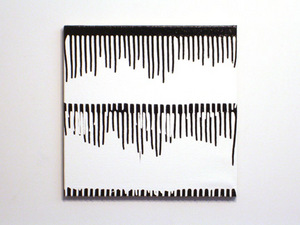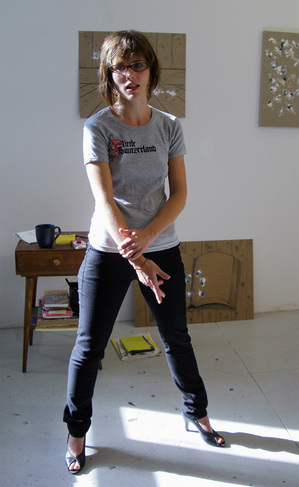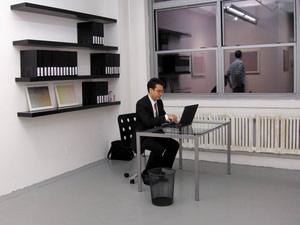This is an archive of the ArtCat Zine, 2007-2009. Please visit our new project, IDIOM.
Form and Enterprise: The Art of Dan Levenson
"This is hilarious" I told artist Dan Levenson, pulling out a thong ornamented with the floral Little Switzerland gallery logo. The sale of t-shirts not to mention exhibition branded lingerie falls considerably short of common within fine art circles, though so do corporate identities with no tax id numbers, bank accounts or regular hours of operation. Without knowing Little Switzerland's background as a conceptual art project about the branding and marketing of art, it might be just as easily confused for a front of some nefarious business enterprise.
Those familiar with the artist's activist efforts during MoMA's grand reopening however, would not make this mistake. Protesting the museum's raise in admission price from 12 dollars to 20 in 2004, Levenson's FreeMoMA.org campaign consisted of a wearable human sized currency, extended protests outside the museum, and informational fliers describing the problem. Since the high profile days of FreeMoMA, Levenson has continued creating work that addresses similar ideas, while maintaining lighthearted approach. "I have an interest in all the ways art work is disseminated that is extraneous from the object" Levenson explained, "the marketing, the advertising, the word of mouth, the hype… and just the business of the art gallery is fascinating to me and a lot of what Little Switzerland is about."
ArtCal Zine: And I imagine your position as an art maker gives you an important and unique perspective…
Dan Levenson: As an artist I am trying to co-opt that business and make it part of my artwork. So I'm interested in the postcards that galleries send out, I'm interested in the catalogs that they print, the essays that are in those catalogs. I love art gallery logos, I love art gallery letterhead, I love printed art gallery advertisements.
AZ: Speaking to this, can you talk about how you feel Little Switzerland identifies itself as an emerging artist gallery?
DL: Well, it’s flexible in terms of the forms it could take, but the story that I have now is that it is a gallery that began in Zürich in 1996 and then moved to Berlin in 1997 where it ran through three seasons and then closed in 1999. So it was an emerging artist gallery that represented a group of emerging Swiss artists. They were all young, they all knew each other, they all went to the same art school and they were all sort of “true believers” in my mind.
AZ: What are true believers?
DL: That’s something that I have a hard time explaining but I guess I divide artists along a spectrum of iconoclasts and true believers, and Little Switzerland is a gallery more for true believers than for iconoclasts. It’s an emerging gallery, so it was a little bit too loud and a little bit too promotional, the way that emerging artist galleries tend to be. We’ve spoken before about Bellwether and how their early graphic identity was a little bit louder and kitschy-er.
AZ: Yeah, their website was an illustrated storefront with someone walking in…
DL: Yea, that’s right! Which I thought was very very cool. And I loved that when they moved to Chelsea they had that pink neon sign that had their logo, which was Bickham Script, a very florid, 17th century-esque font. And of course they’ve toned it down now…I think they are aspiring to something a little bit more respectable and upscale and more Chelsea than Williamsburg. So Little Switzerland is more downtown and they have this kind of loud downtown logo, and then they print t-shirts and they have a kind of whole promotional merchandising aspect that I’m not aware that any real gallery has ever done. I don’t think that galleries generally sell t-shirts and coffee mugs and beer steins and stickers and that kind of stuff, but Little Switzerland does. And more than that, they sort of force their artists in the compromising position of having to model the clothing. So these are the artists modeling.
AZ: I feel like there has to be a gallery that has done that. I believe Mixed Greens had buttons or something like that with pictures of their employee’s faces – they were either business cards of some sort, or a holiday Christmas favor. Either way, I thought they were pretty amusing. Does Little Switzerland have staff members that are identified by name? Obviously you’re the director…
DL: I’m not the director, no. The way I think of it, is that I have to work for them when they come to New York, so I’ve done these performances where I was the gallery assistant in a group show of new Swiss art, I worked in the T-Shirt store, but I don’t work for them directly. I’m not Swiss and the director and all the staff are all Swiss. They’re all fictional, and my relationship to it as Dan Levenson is just tangential.
AZ: So you’re a contractor!
DL: Yeah, just like when galleries from out of town come to New York for the Armory Show…
AZ: And I guess you do a lot of the PR for them?
DL: No. When I send out a press release I use Hans-Ruedi Girschweiler, a fictional Swiss critic. So I wouldn’t say Dan Levenson, because to me, it’s an entirely Swiss/German sort of world. It’s a sort of provincial thing. I mean Zürich has a great art scene but maybe a bit provincial compared to the rest of the world, the rest of Europe, and Little Switzerland does the same.
AZ: Now do you identify with other artists working with similarly fictional concepts? Take for example the Dotted Line at the Rotunda Gallery in Brooklyn, a show featuring scads of self referential fake documentation by artists; also the Homeless Museum… it seems like there is a shared sensibility between these projects.

Courtesy Dan Levenson.
DL: It’s funny, I didn’t know Filip Noterdaeme who runs HoMu until I did the Free MoMA stunt; he was also standing out in front of the museum, and we’ve stayed in touch. He’s been really wonderfully supportive of Little Switzerland. I definitely think there are affinities with the two projects — I can’t speak for Filip or what his project means to him — but for me what I see is the desire not just to engage some kind of institutional critique but to create an entire universe. In my work, I’ve always tried to create some kind of world that I can maneuver through that is infinitely expandable, modular, and that I can change. I mean [when you arrived] you were saying that this part of Little Switzerland looks like a t-shirt or apparel store, and is Little Switzerland an apparel store or an art gallery? And the answer is it can be both. It has an art gallery and it has an apparel aspect to it. And is it in Zürich or is it in Williamsburg? To me, right now, it’s in Zürich, but I would like it to have a Williamsburg branch and I’m working on a project where it would be in Los Angeles, New York, London, Paris, and Berlin. So I’m attracted to those kinds of projects; Matthew Barney type endeavors that can be photo, sculpture, performance; it can also be a long series. I see that in HoMu, though again, I don’t know if that’s how Filip would describe it.
AZ: Getting back the more commercial aspect of the project, the Little Switzerland artists look pretty sexy posing for these photos. I mean, they seem to have an attitude…but I’m not convinced they’re pissed off about modeling the shirts. Are they?
DL: I don’t think that they are pissed off for being made to model. I mean, emerging artists they do a lot of things that maybe they shouldn’t. If I showed at Paula Cooper and she said, “Do you want to model Paula Cooper underwear, I would say yes or no?” (Laughs) But um, I don’t think that they’re pissed off, and they are all young and sexy. They’re sort of like my fantasy of what artists could be.
AZ: Right, and Little Switzerland also has actual artwork that is attributed to the artists in the gallery stable, am I right?
DL: Yeah. I mean, I make all their work for them. I try to keep their styles distinct and consistent. One of the artists, Urs Bereuter, was in a real group show in Chelsea last year, at Jason Rulnick. It was a group show that had Sol LeWitt, Yayoi Kusama, Rob Pruitt… The show was curated by [the gallerist] Jason Rulnick and I think for him it was more about visual affinities between the works. While he appreciated the conceptual aspect of Little Switzerland I think Jason also likes a certain type of abstraction. When he first saw the work, he came to my performance, “New Swiss Art” and initially he thought, like most people did, that it was a group show of new Swiss art, and he just really liked that painting.
AZ: This reminds me of a story I heard in grad school about how Geoffrey Hendricks, a Fluxus artists who is known for throwing his postcards of skies from a ladder into a crowd of gallerygoers, had one of them land on the single cover of Imagine because John Lennon happened to have picked one of them up. It wasn’t entirely coincidental, but along the way the context of the work changes and that that then changes the piece. Do you feel like the work is somehow intrinsically changed taken out of the Little Switzerland show, or is that artist’s work do exactly what you intended it to do in the first place?
DL: Well, part of the fantasy of Little Switzerland is having control over how art work is shown. Control over the context isn’t something artists usually have. I mean work goes into your studio, it goes into your gallery, it goes into a group show, somebody writes about it, maybe you don’t like the other artists you're shown with, maybe you’re not happy being labeled a Fluxus artist or you don’t like the term Neo-geo. I mean, we all lose control of our work, and Little Switzerland began because I didn’t have gallery representation. But it’s important to me to remain flexible and I was happy that Jason liked this painting that it went into the show. I didn’t want to be dictator, and I wanted to let him curate the show and put it together the way he saw fit. I guess it’s like the postcard, you make this artwork, and then you toss it out the window and let it fall where it will.
AZ: The fact that one of your artists paintings has been curated into a show brings to mind the question of finding a gallery. Is gallery representation something you aspire to, or is it merely something or is it just the mechanisms of the gallery world you’re interested in investigating?
DL: I would say the latter; I’m not in a hurry to sign any contracts or anything – it’s not what that’s about.
AZ: You do participate in the business of the gallery world though in the sense that you have objects that are for sale, even if they aren’t typical. You have these limited edition t-shirts, the photographic advertisements.

Courtesy Dan Levenson
AZ: Does this mean you’re naturally inclined to represent mostly painters then?
DL: Little Switzerland is all painting and drawing.
AZ: And within artists communities there’s a certain way that painters dress as opposed sculptors, as opposed to print makers… designers are a whole different world all together.
How careful were you be when you set these advertising shots up? Most painters don’t wear those kinds of heels, but then this is about something slightly different right?
DL: Well I have a vision of her as slightly grungy and glam. There’s a French philosopher named Hélène Cixous who always gives lectures in these incredible spike heels… so it was of somebody like that. I wanted them all to wear glasses and smoke. At some point there will be a sister gallery; the dematerialized gallery. There does seem to be a great divide in the art world between painters and non-painters, so this one will show conceptual art.
AZ: Speaking to the painters, is there other ephemera associated with Little Switzerland we haven’t discussed?
DL: Well we have catalogues of each artist’s work. There’s also the book of Swiss artists. It isn’t specifically a Little Switzerland piece, but part of a larger project that will involve other galleries. The book contains thousands of computer generated Swiss names.
AZ: These books and chronologies are really well put together. You designed the books I take it?
DL: I did. [The project history] is sort of like Star Wars. I started in their second season and I’m going to back to 1996 when they were still in Zürich, before they evolved. I can explore 1998, and their final year of operation in 1999 when they were slightly over the hill.
AZ: [Laughs] You know, I often find failed work just as interesting as the successful stuff so I’m particularly taken with the idea of this final year. I’m going to trust however that Little Switzerland will not fall into the traps of George Lucas, and will at least opt to flounder with paint as opposed to pixels.
ZINE
HOME
TIPS / COMMENTS
CATEGORIES
CONTRIBUTORS
- Greg Afinogenov
- B. Blagojevic
- Adda Birnir
- Susannah Edelbaum
- Julie Fishkin
- Paddy Johnson
- Jessica Loudis
- Christopher Reiger
- Andrew Robinson
- Peter J. Russo
- Blythe Sheldon
- S.C.Squibb
- Hrag Vartanian

